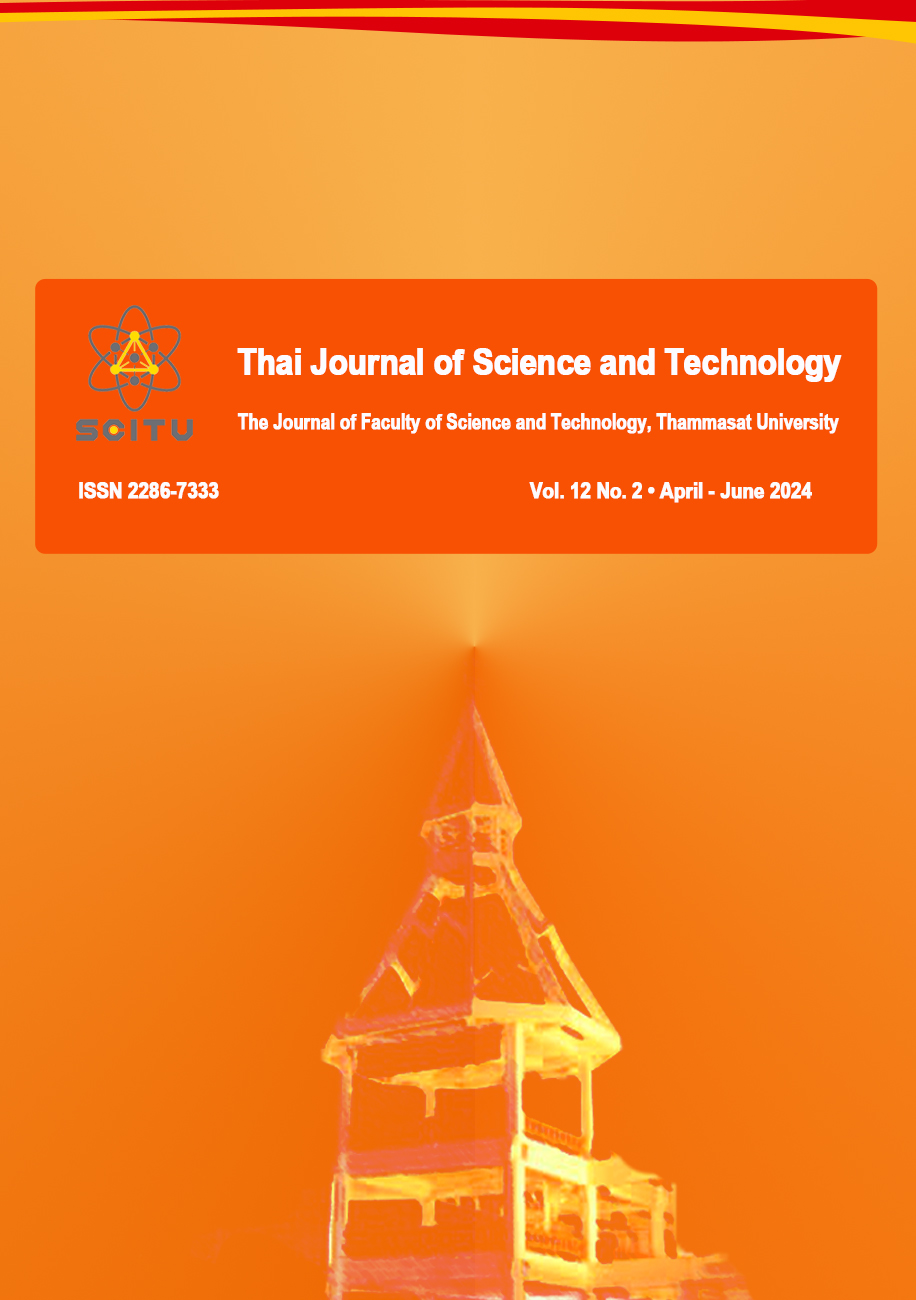Physicochemical Properties and Sensory Evaluation of Butter Cookies Fortified with Fiber from Edamame Soybean Residue Flour
Main Article Content
Abstract
The demand for bakery products that meet criteria such as being gluten-free, nutritious, functional, and sustainable is steadily increasing. Edamame soybean residue is the byproduct derived from the production of Edamame soybean milk, renowned for its abundant fiber and protein content. This study investigated the fortification of fiber in butter cookie products using Edamame soybean residue flour (ESRF), achieved by substituting wheat flour with ESRF at levels of 0, 15, 30, 45, and 60%, respectively. Cookies enriched with higher fiber levels and supplemented with ESRF showed a significant decrease in hardness and crispness (P ˂ 0.05), while experiencing an increase in both fiber and protein content (P ˂ 0.05). Nevertheless, sensory evaluations revealed a notable decline in acceptance of color, texture, taste, and overall liking (P ˂ 0.05). Therefore, the addition of fiber from ESRF in butter cookies at a 15% level resulted in similar sensory acceptability compared to cookies without this fiber supplementation (P ≥ 0.05). However, the fiber-enhanced cookies displayed significantly increased crispness (P ˂ 0.05), along with fiber and protein contents measuring 2.58 and 41%, respectively. This study provides a framework for improving the nutrition of cookies, minimizing production waste, and enhancing the market value of ESRF.
Article Details

This work is licensed under a Creative Commons Attribution-NonCommercial-NoDerivatives 4.0 International License.
บทความที่ได้รับการตีพิมพ์เป็นลิขสิทธิ์ของคณะวิทยาศาสตร์และเทคโนโลยี มหาวิทยาลัยธรรมศาสตร์ ข้อความที่ปรากฏในแต่ละเรื่องของวารสารเล่มนี้เป็นเพียงความเห็นส่วนตัวของผู้เขียน ไม่มีความเกี่ยวข้องกับคณะวิทยาศาสตร์และเทคโนโลยี หรือคณาจารย์ท่านอื่นในมหาวิทยาลัยธรรมศาสตร์ ผู้เขียนต้องยืนยันว่าความรับผิดชอบต่อทุกข้อความที่นำเสนอไว้ในบทความของตน หากมีข้อผิดพลาดหรือความไม่ถูกต้องใด ๆ
References
AACC. (2000). Approved methods of analysis (10th ed.). St. Paul, MN: American Association of Cereal Chemists.
Aggarwal, D., Sabikhi, L., & Sathish Kumar, M.H. (2016). Formulation of reduced-calorie biscuits using artificial sweeteners and fat replacer with dairy–multigrain approach. Journal of the Society of Nutrition and Food Science, 2, 1-7. doi:10.1016/j.nfs.2015.10.001
Agyenim-Boateng, K.G., Zhang, S., Zhang, S., Khattak, A.N., Shaibu, A., Abdelghany, A.M., ... Sun, J. (2023). The nutritional composition of the vegetable soybean (maodou) and its potential in combatting malnutrition. Frontiers in Nutrition, 9. doi:10.3389/fnut.2022.1034115
Amaya-Farfan, J., & Rodriguez-Amaya, D.B. (2021). Chapter 6 - The Maillard reactions. In D.B. Rodriguez-Amaya & J. Amaya-Farfan (Eds.), Chemical changes during processing and storage of foods (pp. 215-263). Academic Press.
AOAC. (2000). Official Methods of Analysis of the Association of Official Analytical Chemists (15th ed.). Association of Official Analytical Chemists.
de Camargo, A.C., Vidal, C.M., Canniatti-Brazaca, S.G., & Shahidi, F. (2014). Fortification of cookies with peanut skins: effects on the composition, polyphenols, antioxidant properties, and sensory quality. Journal of Agricultural and Food Chemistry, 62(46), 11228-11235. doi:10.1021/jf503625p
Ghoshal, G., & Kaushik, P. (2020). Development of soymeal fortified cookies to combat malnutrition. Legume Science, 2(3), e43.
Janhomklai, N., Wannarat, T., Lertkowit, P., & Foophow, T. (2021). Chemical composition and properties of Edamame soybean flour. Journal of Thai Food Culture, 3(1), 21–30. (in Thai)
Kathuria, D., Hamid, Gautam, S., & Thakur, A. (2023). Maillard reaction in different food products: Effect on product quality, human health and mitigation strategies. Food Control, 153, 109911. doi:10.1016/j.foodcont.2023.109911
Krajewska, A., & Dziki, D. (2023). Enrichment of cookies with fruits and their by-products: chemical composition, antioxidant properties, and sensory changes. Molecules, 28(10), 4005. doi:10.3390/molecules28104005
Lalmuanpuia, C., Singh, S.S., & Verma, V.K. (2017). Preparation and quality assessment of fortified cookies by using wheat flour, flaxseed flour and carrot pomace. The Pharma Innovation International Journal, 6(7), 246-250.
Li, C., Stump, M., Wu, W., & Li, Y. (2023). Exploring the chemical composition, antioxidant potential, and bread quality effects of the nutritional powerhouse: Wheat bran – A mini-review. Journal of Agriculture and Food Research, 14, 100898. doi:10.1016/j.jafr.2023.100898
Li, Y., Sun, Y., Zhong, M., Xie, F., Wang, H., Li, L., ... Zhang, S. (2020). Digestibility, textural and sensory characteristics of cookies made from residues of enzyme-assisted aqueous extraction of soybeans. Scientific Reports, 10(1), 4222. doi:10.1038/s41598-020-61179-9
Lin, J., Gu, Y., & Bian, K. (2019). Bulk and surface chemical composition of wheat flour particles of different sizes. Journal of Chemistry, 2019, 5101684. doi:10.1155/2019/5101684
Lorente, D., Duarte Serna, S., Betoret, E., & Betoret, N. (2023). 2 - Opportunities for the valorization of waste generated by the plant-based milk substitutes industry. In A. Basile, A. Cassano, & C. Conidi (Eds.), Advanced Technologies in Wastewater Treatment (pp. 25-66). Location: Elsevier.
Lu, F., Liu, Y., & Li, B. (2013). Okara dietary fiber and hypoglycemic effect of okara foods. Bioactive Carbohydrates and Dietary Fibre, 2, 126-132.
Mba, J.C., Paes, L.T., Viana, L.M., Ferreira, A.J.C., Queiroz, V.A.V., Martino, H.S.D., ... de Barros, F.A.R. (2023). Evaluation of the physical, chemical, technological, and sensorial properties of extrudates and cookies from composite sorghum and cowpea flours. Foods, 12(17), 3261. Retrieved from https://www.mdpi.com/2304-8158/12/17/3261
Melanie, C., & Ignatius Steven, L. (2020). Utilization of edamame bean flour (Glycine Max L. Merr) in making of high protein and low sugar cookies. Paper presented at the Proceedings of the 5th International Conference on Food, Agriculture and Natural Resources (FANRes 2019).
Mudgil, D., Barak, S., & Khatkar, B.S. (2017). Cookie texture, spread ratio and sensory acceptability of cookies as a function of soluble dietary fiber, baking time and different water levels. LWT, 80, 537-542. doi:10.1016/j.lwt.2017.03.009
Nair, R.M., Boddepalli, V.N., Yan, M.-R., Kumar, V., Gill, B., Pan, R.S., ... Somta, P. (2023). Global status of vegetable soybean. Plants, 12(3), 609. Retrieved from https://www.mdpi.com/2223-7747/12/3/609
Redondo-Cuenca, A., Villanueva-Suárez, M.J., & Mateos-Aparicio, I. (2008). Soybean seeds and its by-product okara as sources of dietary fibre. Measurement by AOAC and Englyst methods. Food Chemistry, 108(3), 1099-1105. doi:10.1016/j.foodchem.2007.11.061
Song, J., Liu, C., Li, D., & Gu, Z. (2013). Evaluation of sugar, free amino acid, and organic acid compositions of different varieties of vegetable soybean (Glycine max [L.] Merr). Industrial Crops and Products, 50, 743-749. doi:10.1016/j.indcrop.2013.08.064
Zlatanović, S., Kalušević, A., Micić, D., Laličić-Petronijević, J., Tomić, N., Ostojić, S., & Gorjanović, S. (2019). Functionality and storability of cookies fortified at the industrial scale with up to 75% of apple pomace flour produced by dehydration. Foods, 8(11), 561. Retrieved from https://www.mdpi.com/2304-8158/8/11/561


